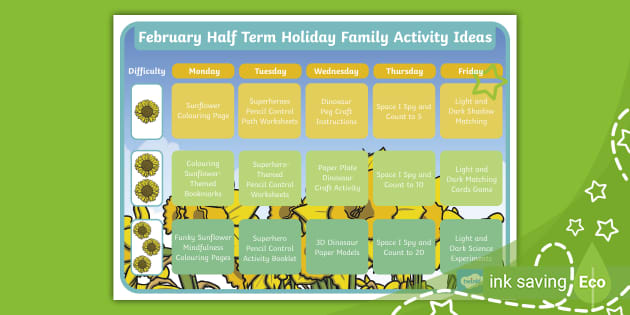February Half-Term: A Time for Family and Adventure
Related Articles: February Half-Term: A Time for Family and Adventure
Introduction
With enthusiasm, let’s navigate through the intriguing topic related to February Half-Term: A Time for Family and Adventure. Let’s weave interesting information and offer fresh perspectives to the readers.
Table of Content
February Half-Term: A Time for Family and Adventure

The February half-term break, typically occurring in late February or early March, is a cherished period for families across the UK. It offers a welcome respite from the often-dreary winter months, providing an opportunity for relaxation, bonding, and creating lasting memories.
This year, the February half-term is anticipated to be a particularly popular time for travel, as many families seek to escape the cold and embrace the promise of warmer climes or exciting adventures. With schools closed for a week, families have the chance to engage in activities that are often difficult to fit into the busy school term.
The Importance of February Half-Term:
The February half-term holds significant importance for both children and parents. For children, it represents a break from the daily routine of school and homework, allowing them to recharge and engage in activities that spark their interests and imagination. The break also provides a chance to strengthen family bonds through shared experiences, fostering a sense of togetherness and creating cherished memories that will last a lifetime.
For parents, the February half-term presents an opportunity to spend quality time with their children, reconnect as a family, and create lasting memories. It also offers a chance to explore new destinations, engage in hobbies, or simply relax and enjoy a break from the daily grind.
Exploring the Benefits:
The February half-term offers a multitude of benefits for families, including:
- Educational Enrichment: The break provides an opportunity for children to learn outside of the classroom, whether through visiting museums, historical sites, or engaging in hands-on activities.
- Cultural Exploration: Families can immerse themselves in different cultures by traveling to new destinations, experiencing local cuisine, and learning about different customs and traditions.
- Physical Activity and Outdoor Recreation: The break allows for time to engage in physical activities, such as skiing, snowboarding, hiking, or simply enjoying a walk in nature.
- Family Bonding and Connection: The shared experiences and time spent together during the break strengthen family bonds and create lasting memories.
- Stress Relief and Relaxation: The break provides a much-needed respite from the pressures of daily life, allowing families to relax, recharge, and enjoy each other’s company.
Planning for February Half-Term:
Planning for the February half-term is crucial to ensure a smooth and enjoyable experience. Here are some key considerations:
- Booking in Advance: Accommodation, flights, and activities often book up quickly, especially during peak periods. Booking in advance is essential to secure the desired options and avoid disappointment.
- Budgeting: It is important to set a realistic budget and stick to it. Consider the cost of accommodation, transportation, activities, and meals.
- Choosing the Right Destination: Consider the interests and preferences of all family members when choosing a destination.
- Packing Appropriately: Pack for all weather conditions and ensure that all essential items, such as medications and travel documents, are included.
- Researching Activities: Research potential activities and attractions in advance to plan your itinerary and make the most of your time.
FAQs about February Half-Term:
Q: When is the February half-term in 2025?
A: The exact dates of the February half-term vary depending on the school district. It is recommended to check with your child’s school for specific dates.
Q: How long is the February half-term?
A: The February half-term typically lasts for one week, but this can vary depending on the school district.
Q: What are some popular February half-term destinations?
A: Popular destinations include ski resorts in Europe, sunny beaches in Spain, Portugal, or the Caribbean, and cities like London, Paris, or Rome.
Q: What are some budget-friendly February half-term activities?
A: Budget-friendly activities include visiting local museums, parks, or libraries, going for walks in nature, or enjoying a family movie night at home.
Q: What are some tips for traveling with children during the February half-term?
A: Pack snacks and drinks for the journey, bring along entertainment such as books, games, or tablets, and plan for breaks along the way.
Tips for a Successful February Half-Term:
- Involve Children in the Planning: Allow children to have a say in choosing activities and destinations.
- Be Flexible: Things don’t always go according to plan, so be prepared to be flexible and adapt to unexpected changes.
- Take Time to Relax: Make sure to schedule in some downtime for relaxation and enjoyment.
- Document Your Experiences: Take photos and videos to capture memories and share them with loved ones.
- Be Present: Put away your phones and other distractions and focus on spending quality time with your family.
Conclusion:
The February half-term is a valuable opportunity for families to create lasting memories, strengthen bonds, and enjoy a well-deserved break from the daily routine. By planning ahead, considering the interests and preferences of all family members, and embracing a spirit of adventure, families can make the most of this special time together.








Closure
Thus, we hope this article has provided valuable insights into February Half-Term: A Time for Family and Adventure. We appreciate your attention to our article. See you in our next article!
